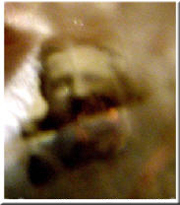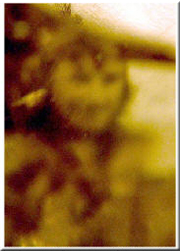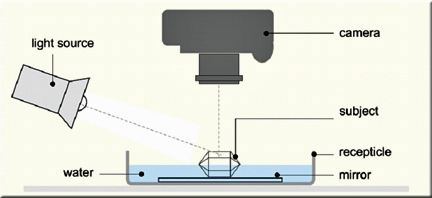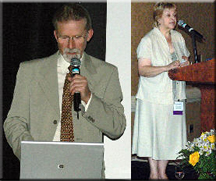Interdimensional Experiments of Diana and Alan Bennett
Diana and Alan speaking at the 2006 ATransC Conference.
Also, see
Diana and Alan Bennett- ITC and Diana and Alan Bennett – ITC 2
First published in the Fall 2006 ATransC NewsJournal
We have carried the ITC work of Diana and Alan Bennett in the NewsJournal a number of times. Through their presentation at the 2006 AA-EVP conference and through the Updated Edition of The Scole Experiment: Scientific Evidence for Life After Death, we are able to share more of their fantastic results as well as information on their experimental methods.

The Bennetts are experimenting with refraction and reflection of light as a means of conditioning optical energy for image formation. As they explained in the updated version of the postscript of The Scole Experiment, “With our light experiments, we generate a vast spectrum of color and intensities bypassing the light source through a crystal. This source itself is variable, which, in turn, causes many different light patterns and colors to be formed. Some of the light frequencies generated are of course beyond our own visible spectrum, so the resulting light contains much more information than we realize.

“We may include a mirror between the source and the crystal (focus) or beyond the focal point, allowing the light to flood back onto the subject. Apart from ordinary mirrors, we have used convex and concave mirrors to very good effect. We have also experimented with polished metallic disks such as brass (yellow) and copper (red), which have created some of the more striking images.”
As you can tell from some of the pictures taken by the Bennetts, they may use water along with a mirror. The camera that they presently use is a Fuji FinePix set on Fine (4048 x 3040 pixels), which produces a computer file of about 12Mb. They focus a concentrated light source onto the side of a crystal and then capture images. The resulting images must be studied in the minutest detail and may have to be magnified as some of the faces can be very small.

The examples shown here display the flaws, facets and textures of the natural quartz crystal used in the experiment. Keep in mind that these characteristics of the crystal may help to make the phenomenal features possible, so a perfect crystal may not be desirable.
The apparent scale of the imperfections should give you some sense of how much the photograph has been enlarged to display the phenomenal feature. Also, the great enlargement is supported by very high-resolution cameras. While the Bennetts are recording files of 12Mb per picture, a video camera will only produce a file of 0.9Mb which will not support such drastic enlargement.
During the conference, the Bennetts strongly suggested that people who plan to work with this technique should also consider the spiritual aspect of the experiment. As world-class mediums, they have learned that contact is often a function of the experimenter’s spiritual attunement.

At this time, the updated version of the Scole Experiments is not available in the USA and must be purchased via Amazon.co.uk. Grant and Jane Solomon are writing a book called the Norfolk Experiment and for updates on their work visit www.thescoleexperiment.com.
![]()

